Soviet aviation anti-tank weapons of the period of the Second World War
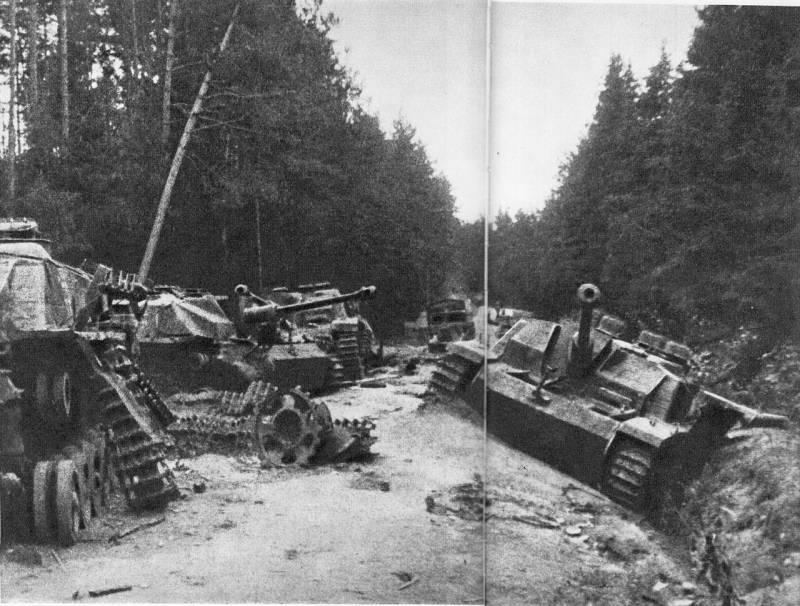
By the beginning of World War II, short-range bombers and attack aircraft, designed to operate along the front line and rear of the enemy, in addition to other tasks, were assigned to fight against enemy armored vehicles. At the same time, at the initial stage of hostilities for these aircraft, there was no truly effective specialized anti-tank weapons.
Aviation artillery armament
By the time Germany attacked the USSR, our aviation there were two types of aircraft guns: 20-mm ShVAK (Shpitalny-Vladimirov aviation large-caliber), the design of which was in many respects similar to the 7,62-mm ShKAS aircraft machine gun and 23-mm VYa (Volkova-Yartseva). These 20-23 mm guns could only penetrate the protection of vehicles covered with bulletproof armor, and shells of this caliber had a low armor effect. An increase in the caliber of aircraft guns to 37–45 mm theoretically made it possible to deal with medium tanks and with some luck - even with heavy ones.
The most massive Soviet aircraft gun of the period of World War II is the 20-mm ShVAK. In terms of its design, the ShVAK was completely similar to the large-caliber 12,7-mm machine gun of the same name, which entered service in 1936. The difference was only in caliber and ammunition. On serial fighters, 20-mm guns began to be installed in 1939. The 20-mm ShVAK cannon was produced in versions: wing-mounted, turret-mounted, and as a motor-gun.
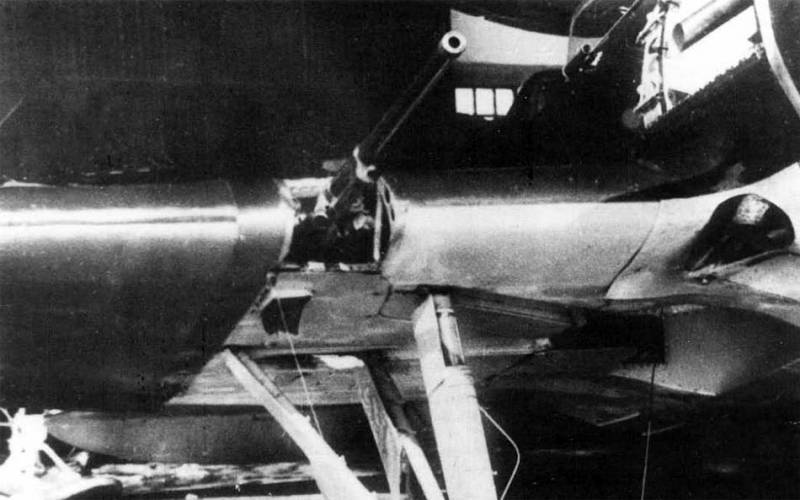
20-mm ShVAK cannon in the wing of the I-16 fighter
Synchronous and wing-mounted 20 mm guns were installed on Soviet fighters I-153P, I-16, Yak-1, Yak-3, Yak-7B, LaGG-3, La-5, La-7, Pe-3. On the part of the British Hurricane fighters delivered to the USSR, rifle-caliber machine guns were replaced with 20-mm cannons.

20 mm ShVAK aircraft gun
The winged version of the ShVAK weighed 40 kg and had a length of 1 mm. Rate of fire - 679-700 rds / min. An armor-piercing incendiary projectile weighing 800 g left the barrel at an initial speed of 96 m/s.
While 20-mm guns performed satisfactorily against enemy aircraft, they proved to be weak against tanks. Shortly after the start of hostilities, it turned out that the armor-piercing 20-mm shell of the ShVAK cannon was capable of penetrating German armor up to 15 mm thick (tanks Pz.II Ausf F, Pz.38 (t) Ausf C, armored personnel carrier Sd Kfz 250) at meeting angles close to to the normal, from a distance of no more than 250–300 m. At meeting angles of 30–40 °, characteristic of an attack from a strafing flight or from a gentle dive, the shells, as a rule, ricocheted.
In 1940, the 23 mm VYa-23 automatic gun was adopted. The recoil of the 23 mm cannon was large enough, and it was not originally installed on fighters. Its only carrier in the initial period of the war was the Il-2 attack aircraft, in each wing of which one VYa cannon was placed with an ammunition load of 150 rounds per barrel. Later, Il-10 attack aircraft and partially LaGG-3 fighters were armed with it. Production aircraft with 23 mm guns began to arrive in August 1941.
With a weight of 66 kg and a length of 2 mm, the gun fired 150–550 rounds per minute. A projectile weighing 650 g had an initial velocity of 200 m/s and pierced 900 mm armor at a distance of 200 m. IL-25, armed with VYa-2 cannons, could hit the armor of light tanks, when attacking the latter from behind or from the side at glide angles up to 23 °.

23 mm aircraft gun VYa
Thus, 20-mm and 23-mm air guns could only effectively deal with armored personnel carriers, armored vehicles and light tanks. In addition, not every armor penetration by a small-caliber projectile, which had a small armor effect, led to the destruction or incapacitation of the tank.
In the fall of 1941, it became obvious that Soviet 20–23 mm caliber aircraft guns were only able to effectively deal with weakly protected vehicles; medium tanks and self-propelled guns were too tough for them. In addition, an increase in the security of enemy armored vehicles was predicted, and in connection with this, the aircraft designer S. V. Ilyushin proposed arming the Il-2 attack aircraft with 14,5-mm machine guns created on the basis of the VYa cannon. However, this proposal did not find support from the Soviet military-political leadership.
The 14,5-mm cartridge with the BS-41 bullet, which used a tungsten carbide core, had the highest armor penetration. At a distance of 300 m, the BS-41 confidently overcame 35 mm armor. However, tungsten carbide, used to make sub-caliber armor-piercing shells, was a scarce material throughout the war. Experts reasonably noted that the consumption of 14,5 mm aviation ammunition would be ten times greater than when firing from anti-tank rifles, and the efficiency was not much higher than when using 23 mm shells.
In the second half of 1942, the Il-2 variant armed with two 37 mm ShFK-37 cannons was released in a small series. This 37-mm aircraft gun was developed under the direction of B. G. Shpitalny.
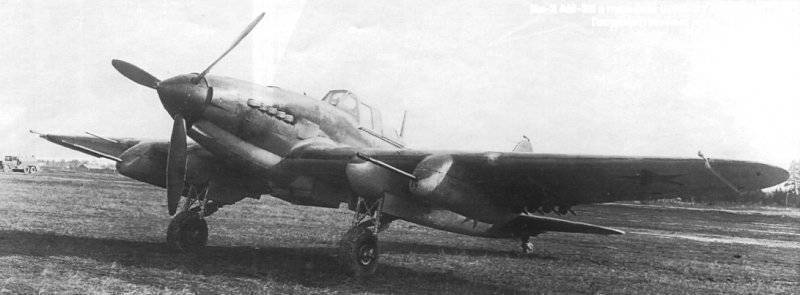
Il-2 attack aircraft armed with 37 mm ShFK-37 guns
The weight of the ShFK-37 gun with ammunition was 302,5 kg. The rate of fire is approximately 170 rds / min, with an initial projectile speed of 890-900 m / s. The gun ammunition included armor-piercing incendiary tracer and fragmentation incendiary tracer shells.
The BZT-37 projectile ensured the penetration of German tank armor 30 mm thick at an angle of 45 ° to the normal from a distance of no more than 500 m. Armor 15 mm thick was penetrated from distances of no more than 16 m at meeting angles not exceeding 60 °. Fragmentation-incendiary shells had less armor penetration, but when they hit the undercarriage, they often disabled it and could effectively hit external tanks, attachments, gun barrels, optics and sights.
The large dimensions of the PFC-37 cannons and the store supply (the capacity of the 40 projectile shop) determined their placement in the fairing under the wing of the IL-2 aircraft. Because of the installation on the cannon of a large store, it had to be strongly lowered down relative to the building plane of the wing (aircraft axis), which not only complicated the design of attaching the cannon to the wing (the cannon was attached to the shock absorber and moved along with the magazine when firing), but also required it is bulky with a large cross-section fairings.
Tests showed that the flight data of the Il-2 with large-caliber ShFK-37 air guns, compared to the serial Il-2, armed with ShVAK or VYa guns, seriously deteriorated. The aircraft became more inert and more difficult in piloting technique, especially on turns and turns at low altitude. At high speeds, maneuverability deteriorated.
Aimed firing from the ShFK-37 cannons on the Il-2 aircraft was largely difficult due to the strong recoil of the cannons during firing and the non-synchronization in their work. The large spacing of the cannons relative to the center of mass of the aircraft, as well as the insufficient rigidity of the cannon mount, led to the fact that the attack aircraft experienced strong shocks, “pecks” and lost its line of sight when firing. This, in turn, taking into account the insufficient longitudinal stability of the attack aircraft, gave a significant dispersion of shells and a sharp decrease in firing accuracy. It was possible to hit the target with a burst length of no more than 2-3 shots. Shooting from one cannon was completely impossible. The attack aircraft immediately turned in the direction of the firing gun so that it was not possible to correct the aiming. Hitting the target in this case could only be the first projectile.
During the entire time of testing, the ShFK-37 guns worked unreliably - the average percentage of ammunition fired per one failure was only 54%. That is, almost every second sortie on a combat mission of an IL-2 with ShFK-37 guns was accompanied by a failure of at least one of the guns. The maximum bomb load of the attack aircraft decreased and amounted to only 200 kg. All this significantly reduced the combat value of an attack aircraft armed with 37-mm guns.
Despite the failure with ShFK-37, work in this direction was continued. In 1943, the production of the NS-37 air gun began (designers A. E. Nudelman and A. S. Suranov). This gun had a belt feed, thanks to which the rate of fire could be increased to 240–260 rds / min. The initial velocity of the projectile is 810 m / s, the weight of the gun is 171 kg. Thanks to tape power and less weight, it became possible to install a new system not only on attack aircraft, but also on fighters.

37 mm NS-37 aircraft gun
Military tests of the gun were carried out on the LaGG-3 from April 21 to June 7, 1943 on the Kalinin Front and on the Yak-9T from July 22 to August 21, 1943 on the Central Front. In July 1943, tests began on a two-seater Il-2 armed with two 37-mm NS-37 cannons. In total, 96 Il-2s with NS-37 participated in military trials.
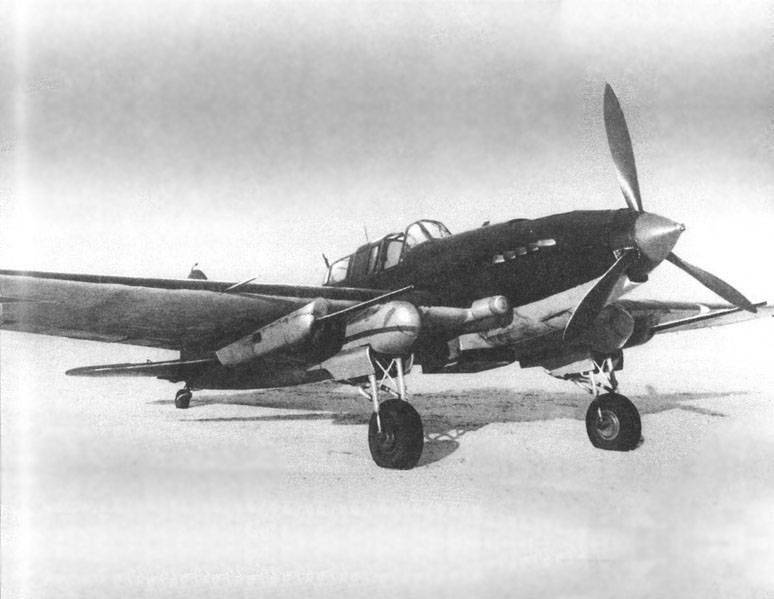
Il-2 attack aircraft armed with 37 mm NS-37 guns
Compared to the ShFK-37, the NS-37 air gun was much more compact, more reliable and had a higher rate of fire. Thanks to the tape feed, it was possible to reduce the size and weight of the system, to place the guns directly at the lower surface of the wing. A relatively small fairing was mounted on top of the gun, consisting of two quick-release flaps. The tape with 37-mm shells fit directly into the wing compartment. The weight of one NS-37 with ammunition was a little over 250 kg.
However, as in the case of ShFK-37, the installation of NS-37 guns significantly worsened flight performance and reduced the bomb load. This was due to the large spread of masses along the span of the wing, the significant weight of the guns of the ammunition load and the fairings, which worsened the aerodynamics of the aircraft. The longitudinal stability of attack aircraft with the NS-37 was significantly worse than that of the Il-2, armed with 20–23 mm cannons, which adversely affected the accuracy of fire. As in the case of ShFK-37, aimed shooting from one cannon was completely impossible. Large-caliber aircraft guns had a crushing recoil, which negatively affected the components and assemblies of the aircraft, and the ammunition was small. In order to confidently get from a cannon into a moving tank, the pilot had to have a fairly high qualification.
According to the reports of the pilots and the data of the photo-machine guns, the number of hits on the target for the spent ammunition was approximately 3%, and hits on the tanks were obtained in 43% of the sorties. According to the pilots who participated in the military tests, the Il-2 with 37-mm aircraft guns did not have any special advantages in attacking small targets over an attack aircraft armed with smaller-caliber guns with a normal bomb load and rockets. Taking into account the significant reduction in flight data and bomb load, experts came to the conclusion that the installation of the NS-37 on the Il-2 did not justify itself. In this regard, attack aircraft armed with 37-mm guns were produced very limitedly.
Taking into account the previous negative experience, the mass production of the Il-2, armed with 45-mm cannons, did not come to fruition. Although such an aircraft was built and tested at the end of 1943.
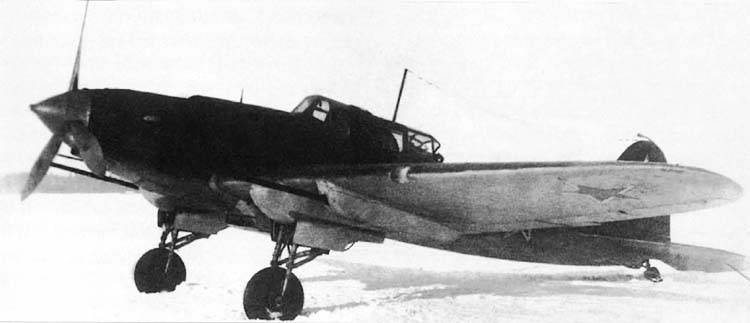
Il-2 attack aircraft armed with 45 mm NS-45 guns
The NS-45 aircraft gun was created on the basis of the NS-37, while maintaining the overall dimensions of the latter. The weight of the NS-45 gun was 150–153 kg. Rate of fire 260–280 rds/min. In the 45-mm aircraft gun NS-45, for the first time in the USSR, a muzzle brake was used on an aircraft, which absorbed up to 85% of the recoil energy.
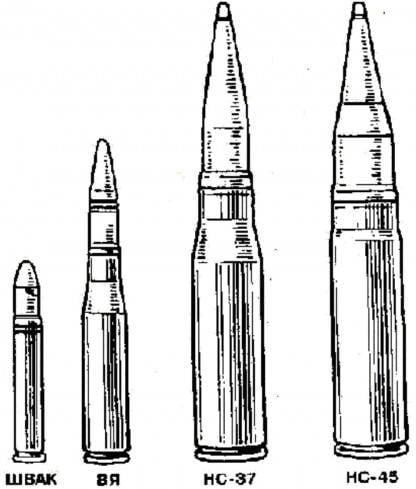
Comparative sizes of projectiles for 20 mm, 23 mm, 37 mm and 45 mm aircraft guns
In 1944–1945 a total of about 200 guns were produced. The Yak-9K (large-caliber) fighter with the NS-45 in the engine disintegration and 29 rounds of ammunition was designed and built specifically for this gun. A total of 53 aircraft of this type were built.
When designing the Yak-9K, it was assumed that these fighters would be able to destroy groups of enemy bombers from a long distance without entering the range of defensive installations, and successfully hit ground targets.
In the period from August 13 to September 18, 1944, the Yak-9K underwent military trials on the 3rd Belorussian Front and from January 15 to February 15, 1945 on the 2nd Belorussian Front. In the course of combat use, ten 45-mm shells were spent on average per shot down enemy aircraft. However, the tests were actually carried out in "greenhouse conditions", because of the worst maneuverability, the Yak-9K needed to be covered by fighters with 20-mm guns.
Aimed fire from 45-mm cannons was obtained only on the first shot, the rest of the shells flew past. After a burst of three shots, due to strong recoil, the flight speed dropped sharply, the stability of the aircraft was lost, oil and water leaked in the pipelines.
According to the results of military tests, the Yak-9K was not launched into mass production.
Aviation rockets
From the first days of the war until the end of hostilities, Soviet aviation actively used rockets against enemy armored vehicles.
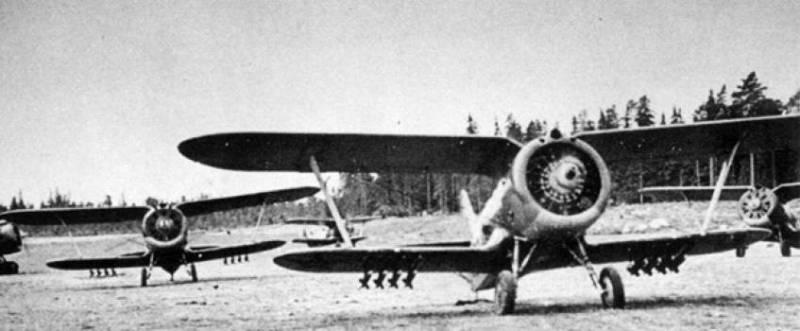
I-153 fighters armed with RS-82 rockets
In June 1941, most of the Soviet fighters could carry 82-mm RS-82 rockets, and Il-2 attack aircraft and Su-2 short-range bombers were also armed with 132-mm RS-132 rockets, up to 8 units.
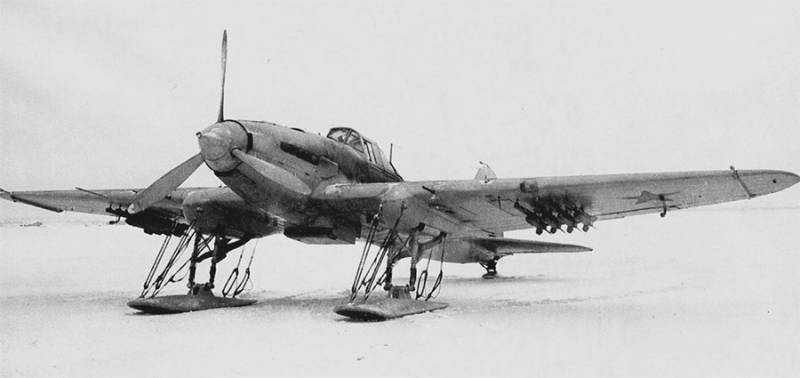
Il-2 attack aircraft of an early modification on a ski chassis, armed with RS-132 rockets
The suspension of the RS-82 and RS-132 under the planes of the aircraft was carried out on launchers of the "flute" type. The installation of rocket launchers with RS increased firepower, but, due to the large frontal resistance and weight, speed decreased and maneuverability deteriorated.
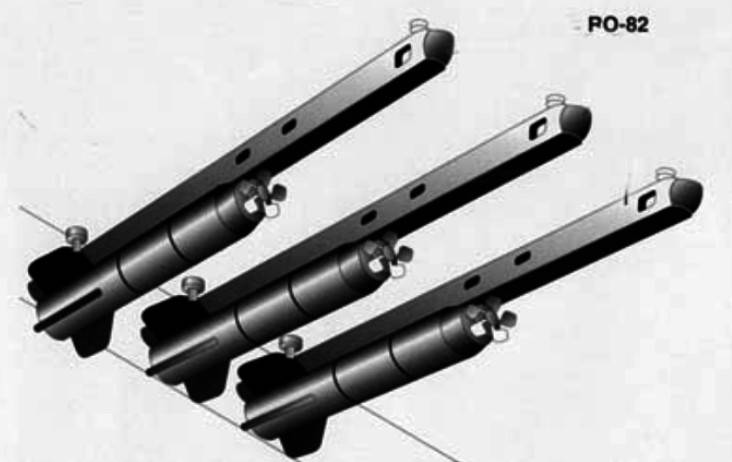
The RS-82 rocket had a weight of 6,82 kg, a fuel charge of 1,06 kg, the warhead was equipped with 360 g of TNT. When firing at ground targets, the projectile was supplied with an impact fuse. For mounting on the launcher, the projectile had four leading pins, and stabilization in flight was carried out by four stabilizers with a span of 200 mm. The halves of the stabilizer were stamped from tin and interconnected by welding. The assembled stabilizer was attached to the corners on the nozzle fairing.
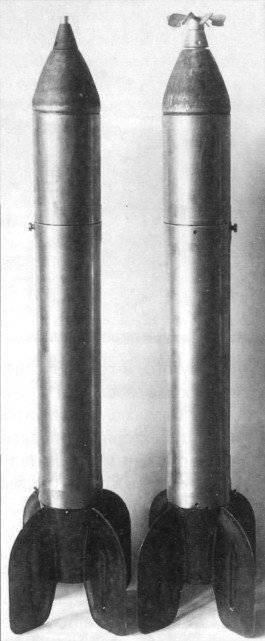
RS-82 missiles with shock and remote fuses
The RS-132 had a generally similar design, but was larger. The total weight of the rocket was 23,1 kg, of which the fuel charge was 3,78 kg, the explosive charge was 1,9 kg.
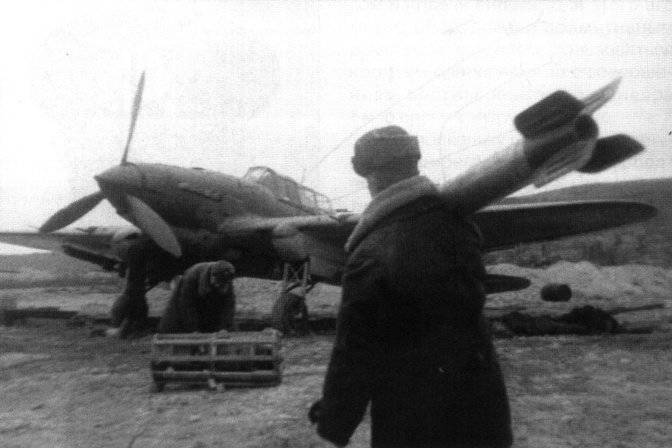
The maximum speed of rockets exceeded 350 m / s. The declared firing range of the RS-82 was 5 m, and the RS-200 - 132 m. But in practice, the maximum firing range, even for large area targets, did not exceed 7 m. Due to the significant dispersion of rocket projectiles, the probability of hitting an individual tank was very low.
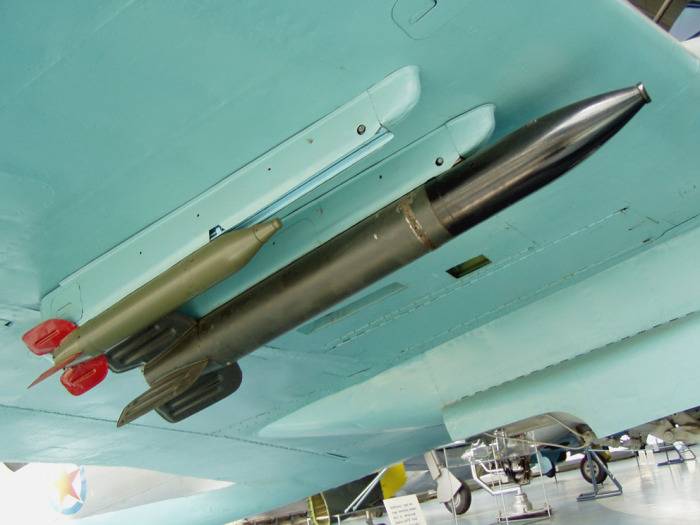
Models of RS-82 and RS-132 under the wing of Il-2
At firing ranges organized in September 1941 to assess the real combat effectiveness of the RS-82 and RS-132, it turned out that the percentage of hits in a single stationary tank was 1,1%, and in a dense tank column - 3,7%. Shooting was carried out with single shells and a volley of 2, 4 and 8 shells. The greatest performance was obtained with volley fire. Shooting was carried out from a height of 100–400 m, with descent angles of 10–30°. Aiming began from 800 m, and the fire opened from 300–500 m.
In addition, the striking capabilities of the RS-82 and RS-132 combat units left much to be desired. With a direct hit, the RS-82 could disable or destroy German light tanks such as Pz.II Ausf F, Pz.38 (t) Ausf C, as well as the Sd Kfz 250 armored vehicle. The much heavier RS-132 was able to break through the armor of medium tanks Pz.Kpfw. III and Pz.Kpfw. IV. But bursts of 132-mm shells at a distance of more than 1 m from the tank did not cause serious damage.
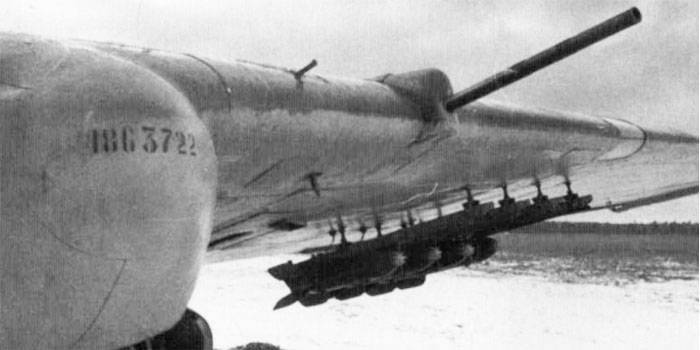
PC-82 under the wing of the IL-2
Nevertheless, the RS was a very effective weapon against areal (artillery batteries and troop positions) and linearly elongated targets (convoys and trains). In the first months of the war, an optimal tactic was developed for dealing with concentrations of enemy troops. Enemy columns and armored vehicles on the Il-2 march were usually attacked from strafing flight (height of approach to the target 25–35 m) along the column or at an angle of 15–20° to its long side. As a rule, the first blow with rockets and cannons was applied to the head of the column in order to block the movement. The range of opening fire is 500-600 m. Before launching rockets, zeroing was carried out with tracer bullets from ShKAS machine guns. Most often, aiming was carried out "along the column" without choosing a specific target.
In 1941, aviation rockets with an armor-piercing warhead were designed specifically for fighting tanks: RBS-82 and RBS-132. The 82 mm projectile normally penetrated 50 mm thick armor, and the 132 mm projectile pierced 75 mm armor. These shells, created on the basis of the RS-82 and RS-132, had a hardened warhead and increased flight speed.

Drawing rocket RBS-132
Armor-piercing rockets were first successfully used in August 1941. However, their mass production began only in the second half of the war. Despite the improved accuracy and armor penetration, the RBS-82 and RBS-132 rockets did not become an effective means of fighting tanks. Armor penetration was highly dependent on the angle of contact with the armor, and the probability of hitting remained low.
The arsenal of the Il-2 and Il-10 attack aircraft also included the ROFS-132 rocket projectile with improved accuracy of fire compared to the RBS-132 or PC-132. The warhead of the ROFS-132 projectile, with a direct hit, provided through penetration of armor up to 50 mm thick.
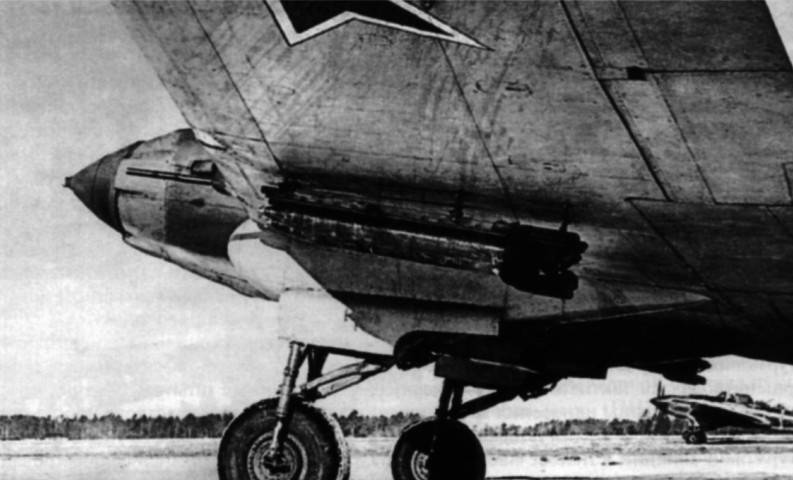
Rocket ROFS-132 under the wing of IL-2
When ROFS-132 exploded near the tank at a distance of 1 m, the kinetic energy of the fragments was enough to break through German tank armor 15–20 mm thick. At the same time, ROFS-132 shells did not have the necessary accuracy against individual tanks. The best results of ROFS-132 were given when firing at large area targets: concentrations of troops, convoys, trains, warehouses, batteries of field and anti-aircraft artillery.
In the second half of 1942, RBSK-82 cumulative rockets were tested, which showed armor penetration up to 50 mm along the normal. In most cases, armor penetration was accompanied by metal spalling around the exit hole. The test commission came to the conclusion that low armor penetration is a consequence of the unsatisfactory operation of the fuse, and the formation of a cumulative jet occurred after the deformation of the cone. It was recommended to finalize the fuses and submit shells for re-testing. Due to the fact that mass production of small-sized cumulative bombs began in 1943, RBSK-82 shells were not put into service.
Aviation weapons of incendiary action
In a number of sources devoted to the combat use of the Il-2 in the initial period of World War II, it is said that cassettes filled with glass ampoules or tin capsules with a self-igniting flammable liquid KS (solution of white phosphorus in carbon disulphide) showed good results against German armored vehicles. If the burning liquid flowed into the tank, then it, as a rule, burned out.
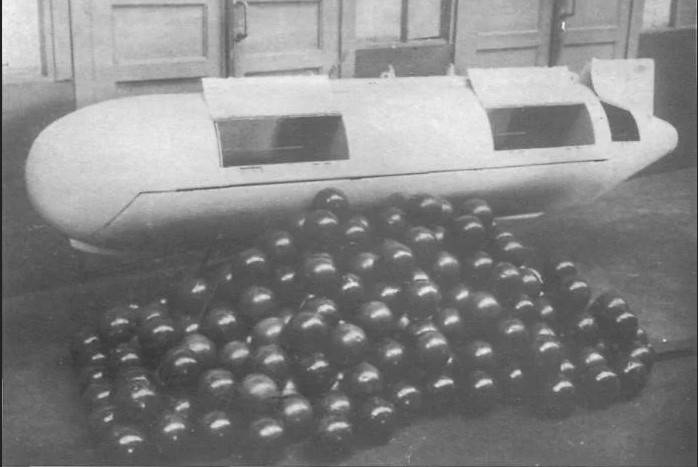
ampoule bomb cassette
The Il-2 small bomb cassettes contained more than 200 ampoules, and it turned out to be quite an acceptable probability of being hit when operating on the battle formations of tanks. However, pilots did not like KS ampoules, since their use was associated with a high risk. In the event of a stray bullet or fragment hitting a bomb cluster and even a slight damage to one ampoule, the aircraft was doomed.
Thermite balls, which were equipped with incendiary aerial bombs ZARP-100, did not justify the hopes placed. 100 balls weighing 485 g each or 100 balls weighing 141 g each were placed in a 300-kg aerial bomb. During a ground explosion of an aerial bomb, thermite balls were scattered within a radius of 15 meters, with an air explosion, the scattering radius was 25–30 meters. The combustion products of the thermite mixture, formed at a temperature of about 3 ° C, could well burn through the relatively thin upper armor.
But the fact was that thermite, which had excellent incendiary properties, did not catch fire instantly. It took a few seconds for the thermite ball to ignite. Thermite balls, which did not have time to flare up, in most cases rolled off the armor of the tanks.
They tried to use 50-100-kg aerial bombs filled with white phosphorus against armored vehicles, which gave good results when used on wooden buildings and other non-fire-resistant targets. Granular white phosphorus with a combustion temperature of about 900 ° C, scattered by an expelling charge, burns out quickly enough, and its combustion temperature is not sufficient to burn through the armor. A tank could be destroyed by a direct hit from a phosphorus incendiary bomb, but this rarely happened.
The incendiary bomb ZAB-100-40P had a case made of 8 mm pressed cardboard coated with varnish, and contained 38 kg of thickened gasoline with a phosphorus fuse and a small bursting charge. The greatest effect against the accumulation of tanks was achieved with an air blast at a height of 15–20 m above the ground. When dropped from a height of 200 m, the simplest grater retarder worked. In case of his failure, the bomb was equipped with a percussion fuse.
The effectiveness of the use of air-blasted incendiary bombs was highly dependent on meteorological conditions and the time of year. Also, for optimal air blasting, it was necessary to strictly control the height of the bombs.
Fragmentation, high-explosive and high-explosive aerial bombs
From the first days of the Great Patriotic War, the main aviation weapons used against tanks were fragmentation, high-explosive fragmentation and high-explosive bombs weighing 25–100 kg. A direct hit from such an airborne munition is guaranteed to destroy any enemy tank. With a close gap, the shock wave destroyed welds and rivets, distorted the undercarriage, swept away external attachments, the crew could get shell shock, and heavy high-speed fragments often damaged optical instruments and weapons, and even pierced the side armor.
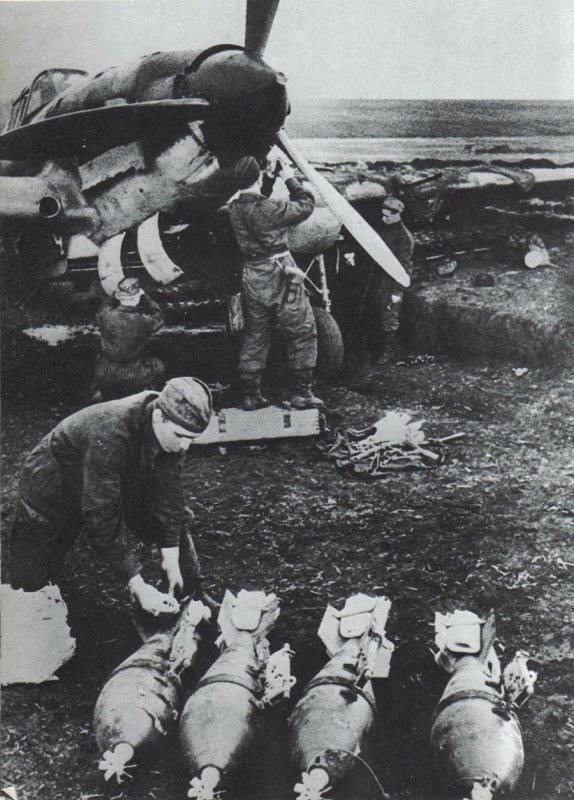
High-explosive fragmentation 50-kg and fragmentation 25-kg bombs with a direct hit on the tank ensured its unconditional defeat, and with a gap of 1–1,5 m, they penetrated armor 15–20 mm thick. The best results were demonstrated by high-explosive fragmentation OFAB-100 equipped with 30 kg of TNT. When using this bomb on enemy armored vehicles, it was possible to penetrate 40 mm of armor at a distance of 3 m, 30 mm at a distance of 10 m and 15 mm at 15 m from the point of explosion.
Another question is that it was very difficult to hit a single tank with a bomb, and therefore bombing attacks were usually carried out on clusters of armored vehicles. At the same time, the specialized armored attack aircraft Il-2 with a normal bomb load of 400 kg, originally created to fight enemy armored vehicles, did not surpass the Pe-2 bomber in its capabilities. When bombing from a dive, the Pe-2, which had a normal bomb load of 600 kg, bombed more accurately.
HEAT bombs
The most effective weapon used by our combat aircraft against enemy tanks was the cumulative anti-tank bombs (PTAB), which were put into service in 1943. Taking into account the fact that the thickness of the upper armor of the tanks did not exceed 30 mm, it was possible to massively use small-sized bombs with a cumulative warhead.

PTAB-2,5-1,5
The new aviation anti-tank ammunition, designated PTAB-2,5-1,5, was a cumulative anti-tank aviation bomb weighing 1,5 kg in dimensions of 2,5 kg of an aviation fragmentation bomb.
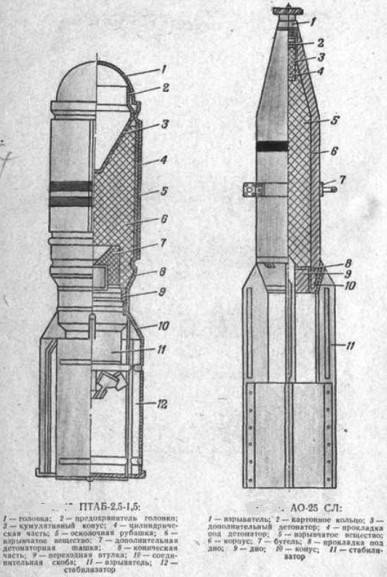
Hulls and riveted stabilizers PTAB-2,5-1,5 were made of sheet steel 0,6 mm thick. For additional fragmentation action, a steel 1,5-mm shirt was put on the cylindrical part of the bomb body. The combat charge consisted of 620 g of TGA mixed explosive (a mixture of TNT, RDX and aluminum powder). To protect the impeller of the AD-A fuse from spontaneous transfer to the combat position, a special fuse was put on the bomb stabilizer from a square-shaped tin plate with a fork of two wire whiskers attached to it, passing between the blades. After dropping the PTAB from the aircraft, it was torn off the bomb by a counter flow of air.
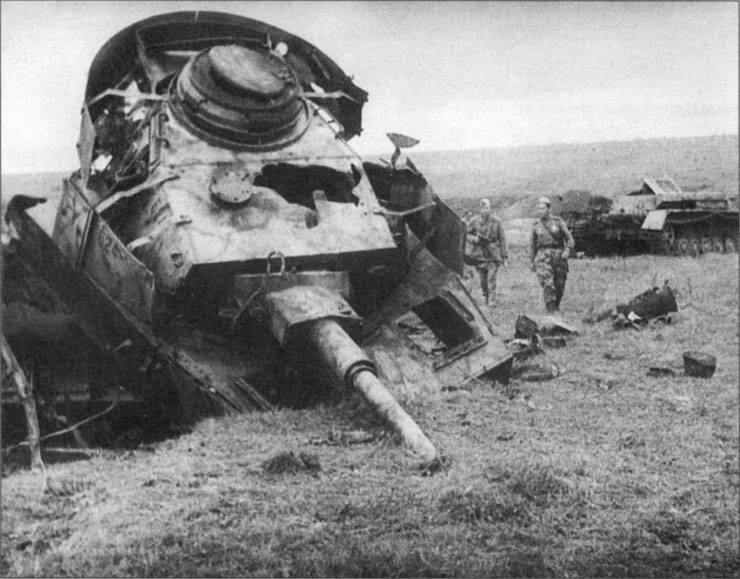
The minimum bomb drop height, which ensures the failure-free operation of the bomb and the leveling of the bomb before it hits the surface of the tank's armor, was 70 m. If ammunition or fuel was encountered along the path of the jet, they detonated and ignited.
Before the enemy was faced with the massive use of PTAB near Kursk, the German command was accustomed to the fact that Soviet aviation usually did not inflict heavy losses on medium and heavy tanks, and air strikes mainly affected transport units involved in the transport of fuel and ammunition.
IL-2 could carry up to 192 cumulative bombs in 4 cassettes, and up to 220 PTAB-2,5-1,5 bombs could be placed in the internal bomb bays. When dropped in horizontal flight from a height of 75–100 m, one attack aircraft was able to cover a 20x80 m strip, destroying all enemy equipment in it.
As a result, the sudden use of new anti-tank bombs not only led to heavy losses, but also had a strong psychological impact on the enemy.
However, the destruction of a tank or self-propelled guns when hit by a cumulative bomb did not always happen. Penetration of the upper armor in the habitable compartment, in the area of the power plant, often led to minor damage, death or injury of 1-2 crew members. In this case, after repair and replenishment of the crew, the armored vehicle returned to service.
In addition, the reliability of the PTAB operation left much to be desired. In about 5% of cases, the fuse's actuating-safety mechanism failed, most often caused by jamming of the impellers in the cylindrical stabilizer, after which the fuse did not cock. On the other hand, even with a relatively high percentage of fuse failures, the massive use of cumulative bombs provided acceptable efficiency. PTAB-2,5-1,5 had a low cost, which made it possible to use them in large quantities, which, as you know, sometimes turns into quality. As of May 1945, more than 13 million HEAT bombs were sent to the active army.
During the war, the irretrievable losses of German armored vehicles from aviation operations, as a rule, were no more than 5%, after the use of PTAB in certain sectors of the front, this figure exceeded 20%. To reduce losses, the Germans switched to dispersed marching and pre-battle formations, which in turn made it very difficult to control tank units, increased the time for their deployment, concentration and redeployment, and complicated the interaction between them.
During stops, German tankers began to place their vehicles under various sheds, trees and install light metal nets over the roof of the turret and hull. The dispersal of combat and marching formations of enemy armored vehicles in the final period of the war, of course, reduced the effectiveness of the PTAB, but cumulative bombs still remained an effective anti-tank weapon, in many respects surpassing 25-100-kg bombs.
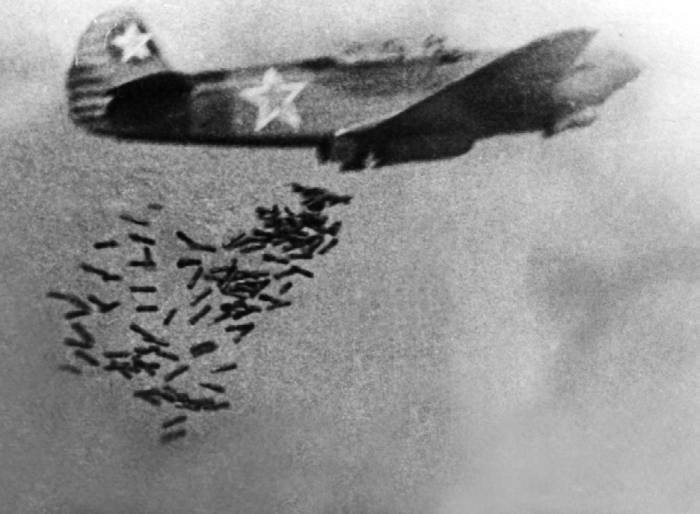
IL-2 was not the only type of combat aircraft of the Red Army Air Force, from which the PTAB was used.
This aviation ammunition, due to its ease and versatility of use, was part of the bomb armament of the Pe-2, Tu-2, Il-4 bombers. In cassettes of small KBM bombs, up to 132 PTAB-2,5-1,5 were hung on Po-2 night bombers. The Yak-9B fighter-bombers could carry four cassettes of 32 bombs each. At the final stage of the war, they were also armed with new Il-10 attack aircraft.
Information